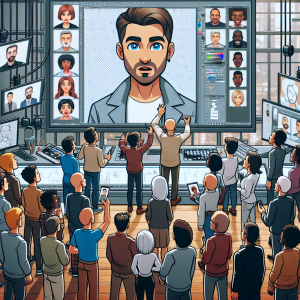The Evolution of Cartoon Dog Faces in Animation
Cartoon dogs have been a staple of animated entertainment for decades, and their faces have undergone significant changes over the years. From the simplistic designs of early animation to the detailed and expressive faces of modern animated films and television shows, the evolution of cartoon dog faces is a fascinating journey through the history of animation. In this article, we will explore the evolution of cartoon dog faces in animation, from the early days of hand-drawn animation to the cutting-edge techniques of computer-generated imagery.
The Early Days: Simple and Playful Designs
In the early days of animation, the design of cartoon dog faces was simple and playful. Characters such as Mickey Mouse’s loyal companion, Pluto, had basic and unassuming features that reflected the limited capabilities of early animation techniques. These early designs were characterized by round, expressive eyes, simple snouts, and minimal facial expressions.
One of the pioneers of early cartoon dog design was Walt Disney, whose iconic character Pluto became a template for the design of cartoon dogs in animation. Pluto’s simple and loveable face set the standard for future animated dog characters, and his design influenced countless other animated dogs in the years to come.
The Golden Age: Detailed and Expressive Faces
As animation techniques advanced, cartoon dog faces became more detailed and expressive. Characters such as Scooby-Doo and Goofy featured more intricate designs, with detailed fur textures, expressive eyes, and a wider range of facial expressions. The golden age of animation saw a shift towards more detailed and lifelike character designs, and cartoon dog faces were no exception.
One of the most notable examples of this shift was the animated film “Lady and the Tramp,” which featured a wide variety of dog characters with highly detailed and expressive faces. The film’s innovative use of animation technology allowed for a new level of detail and realism in the design of cartoon dog faces, setting a new standard for animated character design.
Modern Animation: Cutting-Edge Techniques and Realistic Features
In recent years, the evolution of cartoon dog faces has reached new heights with the advent of computer-generated imagery (CGI) and advanced animation techniques. Characters such as Bolt from Disney’s “Bolt” and Max from “The Secret Life of Pets” feature highly detailed and realistic designs, with lifelike fur textures, intricate facial expressions, and a level of detail that was once unimaginable in hand-drawn animation.
These modern designs push the boundaries of what is possible in animated character design, and the level of realism and detail in cartoon dog faces continues to evolve with each new animated film and television show. The use of advanced CGI techniques allows animators to create incredibly lifelike and expressive designs that were once reserved for live-action films.
FAQs
Q: What are some of the most iconic cartoon dog faces in animation history?
A: Some of the most iconic cartoon dog faces in animation history include characters such as Pluto, Scooby-Doo, Goofy, and Bolt, among others. These characters have had a significant impact on the evolution of cartoon dog faces in animation.
Q: How have advances in animation technology influenced the design of cartoon dog faces?
A: Advances in animation technology, such as CGI and advanced rendering techniques, have allowed for more detailed and lifelike designs in cartoon dog faces. These advances have pushed the boundaries of what is possible in animated character design, leading to highly detailed and realistic designs in modern animated films and television shows.
Q: What are some of the key elements to consider when designing a cartoon dog face for animation?
A: Some key elements to consider when designing a cartoon dog face for animation include the use of expressive eyes, detailed fur textures, and a wide range of facial expressions. These elements contribute to the overall personality and appeal of the character, and are essential for creating engaging and relatable cartoon dog characters.
Q: How has the evolution of cartoon dog faces in animation impacted the overall experience for audiences?
A: The evolution of cartoon dog faces in animation has greatly enhanced the overall experience for audiences, allowing for more realistic and emotionally engaging characters. The level of detail and expressiveness in modern cartoon dog faces has created a deeper sense of connection between audiences and the characters they watch on screen.
In conclusion, the evolution of cartoon dog faces in animation is a captivating journey through the history of animated entertainment. From the simplistic designs of early hand-drawn animation to the cutting-edge techniques of modern CGI, the design of cartoon dog faces has evolved significantly over the years, leading to lifelike and highly expressive characters that continue to captivate audiences around the world.








+ There are no comments
Add yours